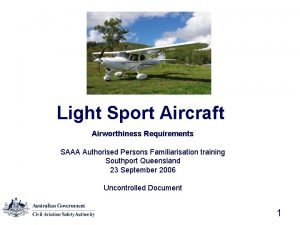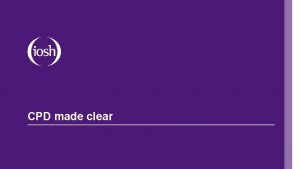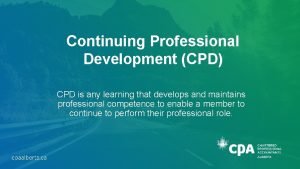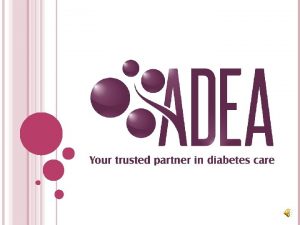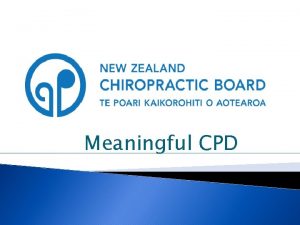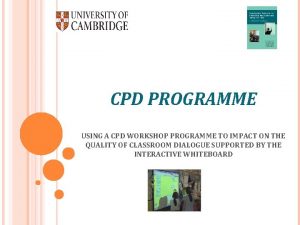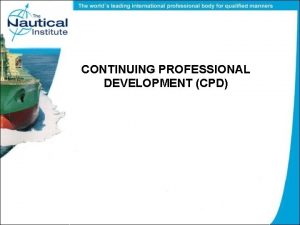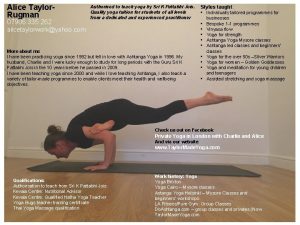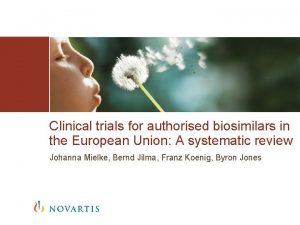Creating authorised teachers the leadership of CPD in



















- Slides: 19

Creating “authorised” teachers: the leadership of CPD in a self -improving school system. Nick Sorensen Bath Spa University n. sorensen@bathspa. ac. uk

Three aims • Reconceptualising the advanced practitioner as the “authorised” teacher • The “authorised” teacher in context • Professional development in a selfimproving school system.

My position 1. Relationship between practice and policy 2. Teaching as a complex activity 3. Growth mindsets: “consistently good and continually improving” 4. Teacher development as a long term process 5. Primacy of relationship between teacher and learner

My research focus • What does it mean to be an advanced practitioner? A redefinition of ‘good’ or ‘best’ practice. • What is the relationship between advanced practice and improvisation? • Understanding sustainable teacher development.

Problem of experienced and expert practitioners • “when we go about the spontaneous, intuitive performance of the actions of everyday life, we show ourselves to be knowledgeable in a special way. Often we cannot say what we know” Schon (1983) cited in Berliner (1986)

Improvisation and advanced practice Professional practice as “ a highly specific process but one that has similarities with others involving the performance of complex and diverse skills in real time and in contexts that are unpredictable and constantly evolving” Atkinson, T and Claxton, G (2000) The Intuitive Practitioner Buckingham: Open University Press

Redefining ‘good practice’ Conclusion: “ a vibrant democracy needs an openended approach to ‘good practice’, which remains within the control of reflexive and learning professionals, which remains sensitive to constantly changing local contexts, and which provides resources to deal appropriately with the complexities involved in its identification and dissemination. ” Coffield and Edward (2009)

The “authorised” teacher Reconceptualising ‘good’ or ‘best’ practice • Authenticity • Authorisation • Authoring

A view of advanced practice Notions of advanced practice are, of necessity, jointly constructed as part of emergent, creative responses to the everyday, complex reality that teachers are engaged with. (Coombs & Sorensen 2010)

Contextualising the ‘authorised’ teacher • Action research movement (Stenhouse 1975) • The Expert Pedagogue (Berliner 1986) • Authentic leadership • Coaching • Masters level PPD – facilitating professional critical reflection • Federations – sharing good practice (school improvement movement)

A golden age of teacher professionalism? Hargreaves + Fullan (2000) Four phases. 1. The pre-professional age (1870 -) 2. The age of the autonomous professional (1960 s -) 3. The collegial professional (post NC) 4. The fourth age

The White Paper • “devolving power to the front line” p 3 • “decisive action to free our teachers from constraint and improve their professional status and autonomy” p 8 • “features of the strongest educational systems combine autonomy and accountability” p 51 • “our aim should be to support the school system to be effectively self-improving” p 13

Creating a self improving school system Hargreaves, D. H. (2010) • Clusters of schools (structure) • Local solutions approach and Co-construction (two cultural elements) • Systems leaders (the key people)

Systems leaders • Introduced by Michael Fullan (2005) • A value: a conviction to strive for success of all schools and all students • A disposition to action: a commitment to work with others • A frame of reference: role of servant leader for the greater benefit of the education system

Implications • Teaching and leading go hand in hand (Barrington et al 2010) Self evaluative practices build leadership skills • System leadership distributed at all levels • Spending time in schools other than their own (learning walks)

Chickens and eggs Which comes first? • School improvement • CPD Should school improvement drive CPD or vice – versa?

Features of an autonomous education system • Leadership of CPD distributed (within schools and across networks) • Action research and enquiry into learnercentred practices to drive school improvement initiatives • Learning walks – experiencing and evaluating other schools approaches • Dissemination of evidences (accreditation? )

Conclusions • White Paper offers opportunity for reclaiming professionalism • Essential to ensure that CPD is recognised as a pro-active driver of school improvement • Role for HEIs / external agencies – “third space”

Creating “authorised” teachers A theoretical model - Sorensen (2010) Critical Reflective Practice Own school The “authorised” teacher Sharing CRP Network Federation HEI Facilitator of CRP “third space”
 Authorised
Authorised Kim kroll teachers pay teachers
Kim kroll teachers pay teachers Situational leadership vs adaptive leadership
Situational leadership vs adaptive leadership Transactional leadership vs transformational leadership
Transactional leadership vs transformational leadership Situational leadership vs adaptive leadership
Situational leadership vs adaptive leadership Các châu lục và đại dương trên thế giới
Các châu lục và đại dương trên thế giới Bổ thể
Bổ thể ưu thế lai là gì
ưu thế lai là gì Tư thế ngồi viết
Tư thế ngồi viết Bàn tay mà dây bẩn
Bàn tay mà dây bẩn Mật thư tọa độ 5x5
Mật thư tọa độ 5x5 Hát lên người ơi alleluia
Hát lên người ơi alleluia Tư thế ngồi viết
Tư thế ngồi viết Ví dụ giọng cùng tên
Ví dụ giọng cùng tên Thẻ vin
Thẻ vin Thơ thất ngôn tứ tuyệt đường luật
Thơ thất ngôn tứ tuyệt đường luật Tỉ lệ cơ thể trẻ em
Tỉ lệ cơ thể trẻ em Sự nuôi và dạy con của hổ
Sự nuôi và dạy con của hổ Từ ngữ thể hiện lòng nhân hậu
Từ ngữ thể hiện lòng nhân hậu Diễn thế sinh thái là
Diễn thế sinh thái là
